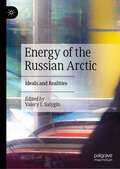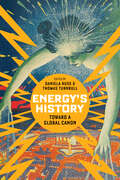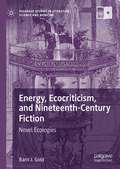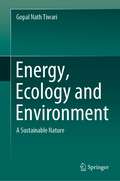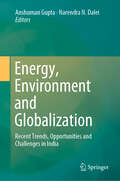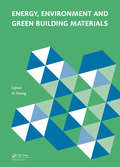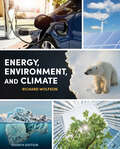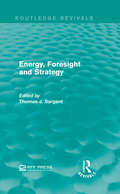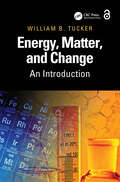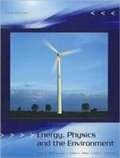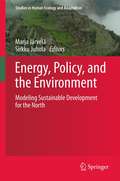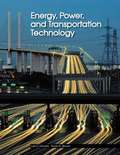- Table View
- List View
Energy of the Russian Arctic: Ideals and Realities
by Valery I. SalyginThis volume is an energy-tailored sequel to the research on the Arctic carried out at MGIMO University. Specifically, the proposed book is grounded in the profound academic and practical expertise of the specialized body of MGIMO University – International Institute of Energy Policy and Diplomacy chaired by Prof. Valery Salygin. Thus, the research exclusively focuses on energy-related aspects of exploration of the Arctic Zone of the Russian Federation (AZRF). This particular region with its ample oil and gas resources has been comparatively and critically studied by a team of authors representing Russia, USA, France, Switzerland, Slovakia, and Lithuania from legislative, political, economic, technical, transport, environmental, sustainability, and security perspectives.
Energy or Extinction?: The Case for Nuclear Energy (Routledge Revivals)
by Fred HoyleOriginally published in 1977 and as second edition in 1979, this book argues that without energy sources on a vast scale our present society cannot survive. According to the author, Fred Hoyle, the technology to tap solar, wind or wave power on a large enough scale just does not exist. He considers nuclear fission to be the only source currently capable of supplying our needs. The author fills in the scientific background necessary to appreciate his arguments in his lucid, direct style, so that the book can act as an ideal introduction for those unfamiliar with the energy debate. This short book is unashamedly provocative and many of the central tenets of it remain as relevant today as when it was first published.
Energy's History: Toward a Global Canon
by Daniela Russ and Thomas TurnbullEnergy history is an approach to understanding the past that takes changes in the human exploitation of Earth's energies as its object of inquiry. This interdisciplinary field documents and analyzes how humans have thought about, harnessed, stored, and exploited stocks and flows of energy. In recent decades, in response to evidence of the effect of fossil fuel use in our climatic system and coinciding with an energy turn across the humanities, a new urgency and purpose has been ascribed to such work. Energy's History challenges abstract and universalizing conceptions of energy's history-making capacities. Each of the twelve essays in this collection presents, analyzes, and contextualizes a primary source. The contributors focus on ideas, events, and statements that recorded and critiqued the distinct historical paths of energy, thereby broadening the scope of where and what constitutes energy history. As energy's world-making has enmeshed ever more of the planet into a dangerous compact with fossil fuels, energy histories must be revised within this new energy-historical reality. This volume both presents persuasive visions of energy-driven development beyond the Western capitalist model and provides an expansive and critical account of the ways in which energy histories have shaped the past and impact the present.
Energy, Ecocriticism, and Nineteenth-Century Fiction: Novel Ecologies (Palgrave Studies in Literature, Science and Medicine)
by Barri J. GoldEnergy, Ecocriticism, and Nineteenth-Century Fiction: Novel Ecologies draws on energy concepts to revisit some of our favorite books—Mansfield Park, Jane Eyre, Great Expectations, and The War of the Worlds—and the ways these shape our sense of ourselves as ecological beings. Barri J. Gold regards the laws of thermodynamics not solely as a set of physical principles, but also as a cultural and conceptual form that we can use to reimagine our historically vexed relationship to the natural world. Beginning with an examination of the parallel inceptions of energy and ecology in the mid-nineteenth century, this book considers the question of how we may better read and interpret our world, developing a recipe for experimental reading and insisting upon the importance of literary studies in a world driving to ecological catastrophe.
Energy, Ecology and Environment: A Sustainable Nature
by Gopal Nath TiwariThis book covers topics related to climate change, weather, greenhouse effect, solar energy, various cycles including carbon, hydraulic, sulphur, renewable energy conservation, ecology and sustainable environment. The contents of the book include pedagogical elements, such as exercises, tables and figures at appropriate places in each chapter, including problems and objective questions at end of each chapter, to aid in learning. Further, the unit conversion from FPS system to SI unit of each parameter, namely length, energy, power, velocity and pressure force, etc, and some standard constants used in examples are also provided in the book. The book also includes discussion about renewable energy sources, namely solar energy, wind energy, biomass energy and geothermal energy, etc, their availability and eco-friendly nature. This book can be a useful reference for those in academia and industry.
Energy, Environment and Globalization: Recent Trends, Opportunities and Challenges in India
by Anshuman Gupta Narendra N. DaleiThis book analyzes contemporary issues relating to energy, environment, and globalization in the Indian context. As a signatory to the Paris climate accord, India has reiterated its commitment to taking strong and positive steps toward climate change mitigation. However, as one of the fastest growing economies in the world, it is battling the effects of a steep rise in fossil fuel usage and pollution. Further, increasing globalization is leading to greater economic activity and production, resulting in additional energy use, which has a negative effect on the environment. The book argues that globalization need not have only a negative environmental impact; it can also have positive impact through the importation of environmentally sound technologies and implementing global compliance standards. The book is divided into three sections: The energy section discusses issues relating to the status of Indian natural gas market and the need for developing an efficient gas market in India; the economics and politics of sustainable energy in India; the challenges of thermal power and significance of clean thermal power generation in India; environmental and policy issues concerning energy use in urban India; the importance of energy use in developing Human Development Index (HDI); and issues relating to renewable energy in India. The environment section then examines topics such as the impact of global warming on local weather by examining the frequency of extreme weather events such as drought and floods, and their impact on farming activities in the Indian state of Odisha; the importance of according the economic value to environmentally significant things like national park , mangroves, etc. for sustainable development; the role of environmental accounting for ecological sustainability and ecotourism; and environmental concerns increasingly gaining traction among the corporate sector for their long-run benefits . Lastly, the third section addresses issues relating to the challenges and opportunities of globalization, such as the interface between globalization and environment; managing India’s business interest in proposing new Bilateral Investment Treaty (BIT); the challenges being faced by Indian exports and their revival; and making Indian SMEs competitive. As such, it is an invaluable resource for policymakers, researchers, practitioners and students in the field of energy, environment and trade economics.
Energy, Environment and Green Building Materials: Proceedings of the 2014 International Conference on Energy, Environment and Green Building Materials (EEGBM 2014), November 28-30, 2014, Guilin, Guangxi, China
by Ai ShengThis proceedings volume contains selected papers presented at the 2014 International Conference on Energy, Environment and Green Building Materials, held in Guilin-Guangxi, China. Contributions cover the latest developments and advances in the field of Energy, Environment and Green Building Materials.
Energy, Environment and Sustainable Development
by Mohammad Aslam Uqaili Khanji HarijanNew information and strategies for managing the energy crisis from the perspective of growing economies are presented. Numerous case studies illustrate the particular challenges that developing countries, many of which are faced with insufficient resources, encounter. As a result, many unique strategies to the problems of energy management an conservation, environmental engineering, clean technologies, biological and chemical waste treatment and waste management have been developed.
Energy, Environment, and Climate (Fourth Edition)
by Richard WolfsonHelp students understand and prepare for a changing energy landscape. With major updates to its coverage of climate and sustainability—particularly as it relates to the latest IPCC reports, trends towards electrification in transportation, and energy policy—the new Fourth Edition of Energy, Environment, and Climate is the most modern, up-to-date text for your energy course.
Energy, Foresight and Strategy (Routledge Revivals)
by Thomas J. SargentThe essays in Energy, Foresight and Strategy apply rational expectation theory to various energy markets with the intention of discussing issues relevant to analysis and decision making in the whole of the energy field. Originally published in 1985, issues explored include oil exportation, energy prices and embargoes, both focussing on how past regulation has created issues in the market at the time of publication as well as creating models to ascertain the futures of various energy resources. This title will be of interest to students of Environmental Studies and Economics.
Energy, Machines, and Motion: Student Guide and Source Book
by National Science Resources CenterNIMAC-sourced textbook
Energy, Matter, and Change: An Introduction
by William B. TuckerThis textbook serves as an introduction to the field of chemistry, aimed at secondary school students, and it assumes no prior knowledge on the readers’ part. As an introductory text, the book emphasizes fundamental skills that are necessary for chemistry, and science generally. This includes an emphasis on good writing and a focus on problem solving, with problems incorporated throughout the text. To help prepare students to pursue chemistry further, all information presented is in accord with the International Union of Pure and Applied Chemistry’s style and technical guidelines and supported through citations to the primary literature.The Open Access version of this book, available at http://www.taylorfrancis.com, has been made available under a Creative Commons [Attribution-Non Commercial-No Derivatives (CC-BY-NC-ND)] 4.0 license.
Energy, Physics And The Environment
by J. L. Campbell E. L. McFarland J. L. HuntEnergy, Physics and the Environment provides a foundational quantitative account of energy and related environmental issues for university students in science who have a first-year preparation in Physics. The text discusses the numbers involved in the various dimensions of the overall energy issue in order to help the reader develop a quantitative grasp on them. This third edition book features an expanded section on uranium resources and the most updated data available. Energy, Physics and the Environment gives students the opportunity to study current energy supply concerns and the impact that energy supply shortage has on the environment.
Energy, Policy, and the Environment
by Sirkku Juhola Marja JärveläThis book sets the questions of energy and the environment in the North in the global context and further addresses historical developments, views on energy taxation and tariffs, and effects of EU energy policy. Climate change appears more frequently than ever on the top of global and national policy agendas. In the current situation traditional environmental concern and environmental policy may not suffice in the face of the global challenge as manifested by climate change and the depletion of fossil energy resources. But as new data comes to light, new energy policies and changes in economic structures are crucial for putting into action global climate policy. Crucial tasks in environmental policy are the sustainable utilisation of natural resources and the conservation of natural and human-made habitats. One of the areas of the world where this comes into play the most is in the Nordic countries. Northern societies are predominantly high tech, high consumption and high energy supply societies. And with the transition from older energy sources (wood for heating and stream water for power production) to newer ones (oil and nuclear energy) discussions on the environmental impact have led to public and corporate action. The Northern countries have been at the forefront in finding sustainable alternatives to solve conflicts arising from the rise in energy needs. However, these countries have taken different pathways with different policies in attempting to achieve this. As the needs and concerns from climate change arise, a Northern dimension, involving policies that contrast to European and global trends, emerges. Energy, Policy, and the Environment: Modeling Sustainable Development for the North explores that dimension.
Energy, Power, And Transportation Technology
by Jack Klasey Ryan A. Brown Len S. LitowitzEnergy, Power, and Transportation Technology provides a comprehensive study of the basic elements of energy, power, and transportation and how they affect the world we live in. This textbook covers the resources, processes, and systems used in these industries. For maximum teaching andlearning flexibility, chapter objectives are divided into Basic Concepts, Intermediate Concepts, and Advanced Concepts. Activities are provided at the end of each chapter to help the student apply the concepts covered in that chapter. Technology Links and Curricular Connections in each chapter helpbroaden student knowledge of technology and connect chapter content with concepts in math, science, and social studies.
Energy, Society and Environment (Routledge Introductions to Environment: Environment and Society Texts)
by David ElliottSociety's use of energy and technology is at heart of many of the most significant environmental problems of recent years, including problems of health, global warming and acid rain. Use of technology has been a major cause of environmental problems but new technology offers many solutions.Energy, Society and Environment is an introduction to energy and energy use, and the interactions between technology, society and the environment. The book is clearly structured to examine:* key environmental issues, and the harmful impacts of energy use* new technological solutions to environmental problems* implementation of possible solutions* implications for society in developing a sustainable approach to energy use.Social processes and strategic solutions to problems are located within a clear, technological context with topical case studies and informative diagrams illustrating key issues.Energy, Society and Environment examines the potential and limits of technical solutions to environmental problems and suggests the social, economic and political changes necessary to avoid serious environmental damage in the future.
Energy, Society and the Environment: Solid-State Hydrogen Storage Materials (SpringerBriefs in Applied Sciences and Technology)
by Mardiana Idayu Ahmad Ali Salehabadi Norli Ismail Norhashimah Morad Morteza EnhessariThis book provides a comprehensive and contemporary overview of advances in energy and energy storage technologies. Although the coverage is varied and diverse, the book also addresses unifying patterns and trends in order to enrich readers’ understanding of energy and energy storage systems, particularly hydrogen energy storage, including e.g. their morphology, porosity and material structure. Readers will also gain insights into the hydrogen storage performance landscape, based on data released by the US Department of Energy (DOE), providing a basis for understanding real-world applications. The book also discusses the superior hydrogen storage performance of solid-state materials and explores the physical and chemical properties that can potentially affect their performance.
Energy, Sustainability and Resilience: A Futuristic Vision from Asia (Disaster Risk Reduction)
by Rajib Shaw Kampanart Silva Nuwong ChollacoopThis book analyzes the experiences of energy, sustainability and resilience issues from different Asian countries and puts forward a futuristic vision of an energy sector for sustained development. Energy is at the core of development, but in energy generation, there are severe environmental implications in many cases. This clearly affects development and causes significant challenges to sustainability. Climate change and disasters have an effect on energy infrastructures and also make significant impacts on humans in terms of both shocks and stresses. Therefore, it is extremely important to understand the linkage of energy, sustainability and resilience. Asia is a hotspot of climate change and disasters, suffering from severe damages to the energy infrastructure of the countries there. At the same time, being a core of world development trajectories, Asia produces and consumes more energy in different sectors than any other part of the world. Also, however, Asia serves as a core region of innovative ideas in energy and related sectors.
Energy, Transport, & the Environment
by Oliver Inderwildi Sir David KingSustainable mobility is a highly complex problem as it is affected by the interactions between socio-economic, environmental, technological and political issues. Energy, Transport, & the Environment: Addressing the Sustainable Mobility Paradigm brings together leading figures from business, academia and governments to address the challenges and opportunities involved in working towards sustainable mobility. Key thinkers and decision makers approach topics and debates including: energy security and resource scarcity greenhouse gas and pollutant emissions urban planning, transport systems and their management governance and finance of transformation ·the threats of terrorism and climate change to our transport systems. Introduced by a preface from U.S. Secretary of Energy, Steven Chu and an outline by the editors, Dr Oliver Inderwildi and Sir David King, Energy, Transport, & the Environment is divided into six sections. These sections address and explore the challenges and opportunities for energy supply, road transport, urban mobility, aviation, sea and rail, as well as finance and economics in transport. Possible solutions, ranging from alternative fuels to advanced urban planning and policy levers, will be examined in order to deepen the understanding of currently proposed solutions within the political realities of the dominating economic areas. The result of this detailed investigation is an integrated view of sustainable transport for both people and freight, making Energy, Transport, & the Environment key reading for researchers, decision makers and policy experts across the public and private sectors.
Energy, Transport, & the Environment: Addressing the Sustainable Mobility Paradigm
by Oliver Inderwildi Sir David KingSustainable mobility is a highly complex problem as it is affected by the interactions between socio-economic, environmental, technological and political issues. Energy, Transport, & the Environment: Addressing the Sustainable Mobility Paradigm brings together leading figures from business, academia and governments to address the challenges and opportunities involved in working towards sustainable mobility. Key thinkers and decision makers approach topics and debates including: energy security and resource scarcity greenhouse gas and pollutant emissions urban planning, transport systems and their management governance and finance of transformation·the threats of terrorism and climate change to our transport systems. Introduced by a preface from U.S. Secretary of Energy, Steven Chu and an outline by the editors, Dr Oliver Inderwildi and Sir David King, Energy, Transport, & the Environment is divided into six sections. These sections address and explore the challenges and opportunities for energy supply, road transport, urban mobility, aviation, sea and rail, as well as finance and economics in transport. Possible solutions, ranging from alternative fuels to advanced urban planning and policy levers, will be examined in order to deepen the understanding of currently proposed solutions within the political realities of the dominating economic areas. The result of this detailed investigation is an integrated view of sustainable transport for both people and freight, making Energy, Transport, & the Environment key reading for researchers, decision makers and policy experts across the public and private sectors.
Energy, entropy, creativity: What drives and slows economic growth
by Reiner Kümmel Dietmar Lindenberger Niko PaechThis book helps to understand the importance of thermodynamics for economics, the environment and society. It argues for the integration of the first two laws of thermodynamics into textbook economics. In doing so, systemic similarities in thermodynamics and the theory of economic growth lead to the use of similar mathematical methods that allow industrial economies to be described realistically. From this, the authors propose tools for solving social and environmental problems. The book is aimed at all those interested in interdisciplinary research on the development problems of the economy and society and who want to understand what drives their upheavals. The authors of the book have been dealing with these development problems for a long time: the theoretical physicist Reiner Kümmel from the University of Würzburg, the physicist and economist Dietmar Lindenberger from the University of Cologne and the Energy Economics Institute at this university, and the economist Niko Paech from the University of Siegen. "It is my pleasure to recommend this book to readers. It is driven by the idea of exploring the physical limits of human economic activity using thermodynamics, one of the most universal physical theories we have." Comment on the original German edition by Dieter Meschede, Professor of Physics, University of Bonn
Energy, the Environment, and Sustainability (Mechanical and Aerospace Engineering)
by Efstathios E. MichaelidesEnergy and the Environment explains in simple terms what the energy demand is at the present, what the environmental effects of energy use are, and what can be accomplished to alleviate the environmental effects of energy use and ensure adequate energy supply. Though technical in approach, the text uses simple explanations of engineering processes and systems and algebra-based math to be comprehensible to students in a range of disciplines. Schematic diagrams, quantitative examples, and numerous problems will help students make quantitative calculations. This will assist them in comprehending the complexity of the energy-environment balance, and to analyze and evaluate proposed solutions.
Energy-Aware System Design
by Chong-Min Kyung Sungjoo YooPower consumption becomes the most important design goal in a wide range of electronic systems. There are two driving forces towards this trend: continuing device scaling and ever increasing demand of higher computing power. First, device scaling continues to satisfy Moore's law via a conventional way of scaling (More Moore) and a new way of exploiting the vertical integration (More than Moore). Second, mobile and IT convergence requires more computing power on the silicon chip than ever. Cell phones are now evolving towards mobile PC. PCs and data centers are becoming commodities in house and a must in industry. Both supply enabled by device scaling and demand triggered by the convergence trend realize more computation on chip (via multi-core, integration of diverse functionalities on mobile SoCs, etc.) and finally more power consumption incurring power-related issues and constraints. Energy-Aware System Design: Algorithms and Architectures provides state-of-the-art ideas for low power design methods from circuit, architecture to software level and offers design case studies in three fast growing areas of mobile storage, biomedical and security. Important topics and features: - Describes very recent advanced issues and methods for energy-aware design at each design level from circuit and architecture to algorithm level, and also covering important blocks including low power main memory subsystem and on-chip network at architecture level - Explains efficient power conversion and delivery which is becoming important as heterogeneous power sources are adopted for digital and non-digital parts - Investigates 3D die stacking emphasizing temperature awareness for better perspective on energy efficiency - Presents three practical energy-aware design case studies; novel storage device (e.g., solid state disk), biomedical electronics (e.g., cochlear and retina implants), and wireless surveillance camera systems. Researchers and engineers in the field of hardware and software design will find this book an excellent starting point to catch up with the state-of-the-art ideas of low power design.
Energy-Based Control of Electromechanical Systems: A Novel Passivity-Based Approach (Advances in Industrial Control)
by Ramón Silva-Ortigoza Victor Manuel Hernández-Guzmán Jorge Alberto Orrante-SakanassiThis book introduces a passivity-based approach which simplifies the controller design task for AC-motors. It presents the application of this novel approach to several classes of AC motors, magnetic levitation systems, microelectromechanical systems (MEMS) and rigid robot manipulators actuated by AC motors. The novel passivity-based approach exploits the fact that the natural energy exchange existing between the mechanical and the electrical subsystems allows the natural cancellation of several high order terms during the stability analysis. This allows the authors to present some of the simplest controllers proposed in scientific literature, but provided with formal stability proofs. These simple control laws will be of use to practitioners as they are robust with respect to numerical errors and noise amplification, and are provided with tuning guidelines. Energy-based Control of Electromechanical Systems is intended for both theorists and practitioners. Therefore, the stability proofs are not based on abstract mathematical ideas but Lyapunov stability theory. Several interpretations of the proofs are given along the body of the book using simple energy ideas and the complete proofs are included in appendices. The complete modeling of each motor studied is also presented, allowing for a thorough understanding.Advances in Industrial Control reports and encourages the transfer of technology in control engineering. The rapid development of control technology has an impact on all areas of the control discipline. The series offers an opportunity for researchers to present an extended exposition of new work in all aspects of industrial control.
